#Mexican History
Text


Happy birthday Frida Kahlo!
Frida was born in Mexico City on 6 July 1907. Her art draws on both European and Mexican traditions to focus on themes including gender, revolutionary politics, and Mexican nationalism.
Frida’s works were exhibited during her lifetime in several countries, including at the USA’s MoMA. In 1939, the Louvre purchased one of the portraits, making her the first Mexican artist included the their collection.
Frida was married for much of her life to fellow artist Diego Rivera, and also had relationships with several women.
Check out our podcast on Frida to learn more!
#frida kahlo#bi history#queer history#lgbt#lgbtq#queer#lgbt history#mexican history#bisexual history
265 notes
·
View notes
Text

[Image description: a clip of a headline that reads: Mexican history> Mexican government acquires long-lost Aztec manuscripts a out the rise and fall of Tenochtitlan]
The National Museum of Anthropology in Mexico City has announced the discovery of the Codices of San Andrés Tetepilco, three codices nearly 500 years old, telling the history of the city of Tenochtitlán. It includes details of life before and after European contact and conquest, written in a mix of Nahuatl, Spanish, and Indigenous Mesoamerican painting styles.
The indigenous people of Mexico and Central America, including civilizations before the Aztecs, had a very complete written history. However, most of these texts were burned by Spanish conquistadores, making findings like this very exciting.

[Image description: a page of the Codices of San Andrés Tetepilco, showing the inventory of a church on bark paper via imagery. It is faded and ripped in many places]
371 notes
·
View notes
Text

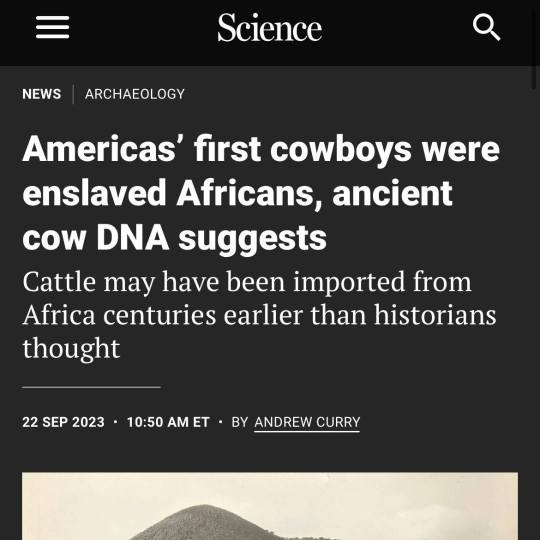
"...the first cowboys lived in Mexico and the Caribbean, and most of them were Black.
That’s the conclusion of a recent analysis of DNA from 400-year-old cow bones excavated on the island of Hispaniola and at sites in Mexico. The work, published in Scientific Reports, also provides evidence that African cattle made it to the Americas at least a century earlier than historians realized.
The timing of these African imports—to the early 1600s—suggests the growth of cattle herds may have been connected to the slave trade, says study author Nicolas Delsol, an archaeozoologist at the Florida Museum of Natural History. “It changes the whole perspective on the mythical figure of the cowboy, which has been whitewashed over the 20th century.”
x
#cowboys#african heritage#caribbean history#mexican history#dna analysis#historical perspective#slave trade#cattle herds#cultural reevaluation#17th century#black cowboys#early americas#black history
402 notes
·
View notes
Note
Hello! I think your blog title is absolutely lovely (do flowers go down to the realm of the dead?) and I’d like to ask if that’s a quote of your own or if it’s from something else? It’s such a beautiful quote either way!
It's actually a quote from a late-medieval (15th century) Aztec philosopher-king named Nezahualcoyotl. As I first encountered it:
"Truly do we live on Earth?" asked a poem or song attributed to Nezahualcoyotl (1402-72), a founding figure in Mesoamerican thought and the tlatoani of Texcoco, one of the other two members of the Triple Alliance. His lyric, among the most famous in the Nahuatl canon, answers its own question:
Not forever on earth; only a little while here.
Be it jade, it shatters.
Be it gold, it breaks.
Be it a quetzal feather, it tears apart.
Not forever on earth; only a little while here.
In another verse assigned to Nezahualcoyotl this theme emerged even more baldly:
Like a painting, we will be erased.
Like a flower, we will dry up here on earth.
Like plumed vestments of the precious bird,
That precious bird with the agile neck,
We will come to an end.
Contemplating mortality, thinkers in many cultures have drawn solace from the prospect of life after death. This consolation was denied to the Mexica [Aztec], who were agonizingly uncertain about what happened to the soul. "Do flowers go to the region of the dead?" Nezahualcoyotl asked. "In the Beyond, are we still dead or do we live?" Many if not most tlamantine saw existence as Nabokov feared: "a brief crack of light between two eternities of darkness."
-- Charles Mann, 1491: New Revelations of the Americas Before Columbus (New York: Vintage Books, 2011), p. 138.
This quote hit me in the heart the first time I read it, as a lovely and achingly poignant question on the nature of eternity, especially since it came from a member of a world and a culture scoured totally out of existence by the conquering, colonizing Spaniards. It is a timeless impulse to wonder whether loved ones are ever truly gone, if beautiful things survive after we have lost them, if they go on existing somewhere, even when we can no longer see or touch them. Astute and/or comprehensive readers may know that this quote is directly referenced in both a Sandman and a Shadow and Bone fic of mine, so yes.
84 notes
·
View notes
Text
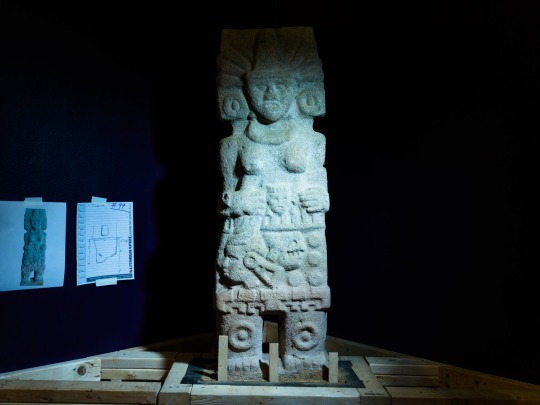
"The woman, carved in pale stone, wears a peaked headdress, circular earrings and the wide hip belt and kneepads of an ancient Mesoamerican athlete. Her expression is fierce, her pose triumphant. In her right hand, she grips the severed head of a sacrificial victim by the hair.
The sculpture is the first life-size representation of a ritual ballplayer found to date in the Huasteca, a tropical region spanning parts of several states along the Gulf Coast of Mexico.
Like virtually every other Mesoamerican society, the inhabitants of the Huasteca played what is simply known today as “the ballgame,” in the time before the Spanish conquest. Despite its name and ties to modern soccer, this game was more sacred rite than sport.
For the players, who bounce a solid, dangerously heavy rubber ball off their hips, it was a means of communing with the gods, one that sometimes culminated in human sacrifice.
The ballplayer will be among the most important artifacts in an exhibit, “Ancient Huasteca Women: Goddesses, Warriors and Governors,” at the National Museum of Mexican Art in Chicago, opening Friday. This is the first time the piece, which was discovered by landowners about 50 years ago near Álamo, Veracruz, has been on public display.
“It is a totally atypical sculpture,” said David Antonio Morales, an archaeologist with the National Institute of Anthropology and History in Veracruz, who stumbled upon it last November when he was visiting private collections.
He contacted María Eugenia Maldonado, one of the few archaeologists specializing in the pre-Columbian past of the Huasteca. At first, she didn’t think the figure could be real. It would be the first stone sculpture of a ballplayer found in the region, the first female ballplayer and the first at this scale holding a decapitated head.
“It’s putting all the elements into a single sculpture that had never been seen together before,” she said. “That is the importance of this sculpture.”
Kim N. Richter, a historian of pre-Columbian art at the Getty Research Institute in Los Angeles and an expert on female statues from the region, had not seen the piece. It “would be really important because we don’t have any monumental sculptures of ballplayers in the Huasteca to date, male or female,” she said. “So that would be a huge discovery in itself.”
Dr. Maldonado says she hopes the exhibition, with 100 artifacts, will challenge what she calls “superficial” interpretations of women’s roles that have riddled scholarship of the region. For decades, archaeologists have described sculptures of men as individuals in positions of power, like priests or rulers. They’ve tended to brush aside sculptures of women as images of a fertility goddess.""
#history#women in history#women's history#sportswomen#athletes#women in sports#mesoamerica#mesoamerican history#mexico#mexican history#huasteca#historyblr#historical figures#artefacts#sculptures#archeology
67 notes
·
View notes
Photo

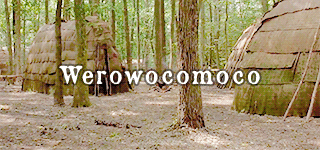

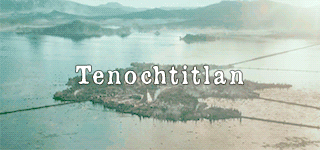



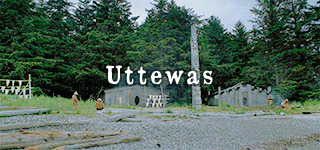
Pre-colonial Native American cities/settlements/meeting sites.
Sivan Vahki: just north of Casa Grande, Arizona, Sivan Vahki or Siwañ Waʼa Ki: was a large farming and trade network site of the Sonoran Desert people starting in the early 13th century.
Werowocomoco: With habitation beginning from the 13th century, Werowocomo was a village that later served as the headquarters of the werowance Wahunsenacah, Paramount Chief of the Powhatan confederacy.
Cahokia: Mississippian culture city dating from circa 1050–1350 CE, containing elaborately planned community, woodhenge, mounds, and burials.
Tenochtitlan: built atop a lake, Tenochtitlan was an Aztec altepetl, and was the largest city in the pre-columbian Americas at its peak. It is considered one of the most impressive cities in North America, and is today known as Mexico city.
Tikal: one of the most powerful ancient kingdoms of the Maya, and dates back as far as the 4th century BC, and may have had a population of up to 90,000.
Omahkoyis: Meeting place and trading and cultural hub for the Blackfoot, and later other tribes as well as settlers. The Blackfoot and their ancestors had inhabited the area as early as 12,000 BC, and would later also be known by other names. Colonizing efforts turned the area into a settlement, known today as the city of Edmonton.
Qusqu: also known as “Cuzco”, the city served as the capital for the Inca Empire from the 13th century up into the 16th century upon colonization. However, evidence shows that The Killke people occupied the region from 900 to 1200 CE, prior to the arrival of the Inca, and had constructed a fortress about 1100 CE.
Uttewas: later known as “Old Masset”, was one of the largest Haida villages on Haida Gwaii, and is home to a number of important cultural artifacts, such as numerous totem poles. Today its land is legally designated as Masset Indian Reserve No. 1.
#historyedit#Native American history#canadian history#american history#mexican history#peruvian history#cahokia#tenochtitlan#tikal#maya#aztec#nahua#history#justin's edits#ndn#native american
1K notes
·
View notes
Text
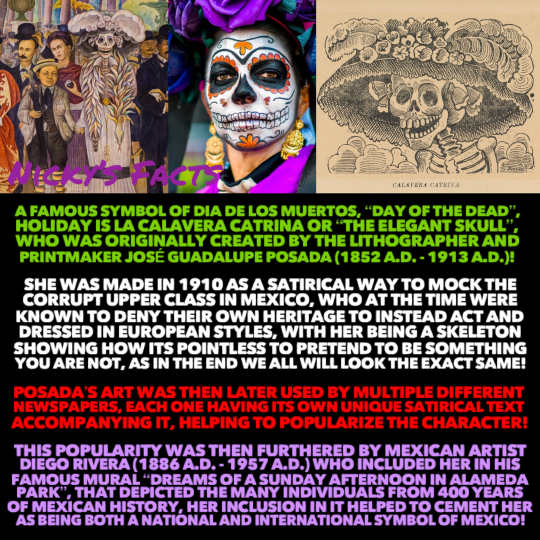
Happy Dia de los Muertos to la Calavera Catrina!🥳
🇲🇽💀🇲🇽
#history#dia de los muertos#la catrina#day of the dead#holiday#mexican history#be yourself#art#latina#josé guadalupe posada#historical figures#latin american history#diego rivera#mexican culture#halloween#female icons#beautiful#femininity#mexico#art history#hispanic culture#celebration#latin america#dreams of a sunday afternoon in alameda#mexico city#nickys facts
99 notes
·
View notes
Text
Okay, hear me out, drawing Rudy and Alejandro in an outfit inspired by Mexican revolutionaries like Emiliano Zapata.
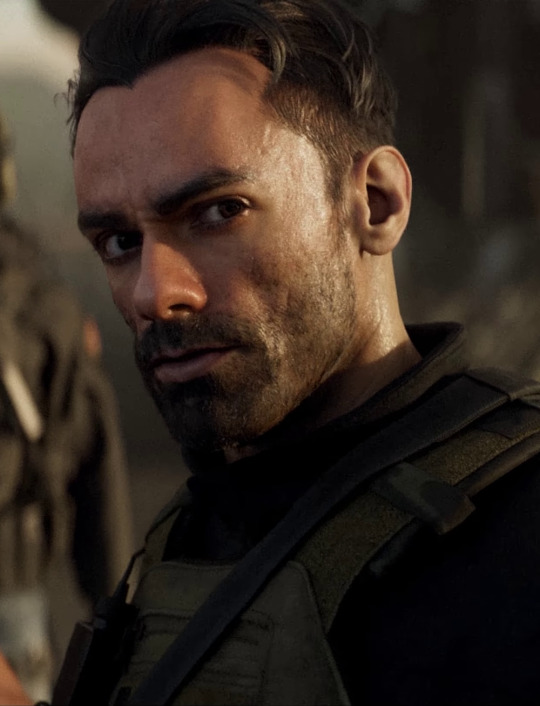

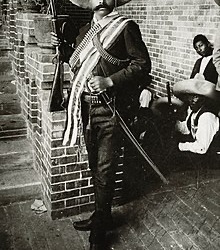
#cod mwii#call of duty mw2#call of duty modern warfare ii#alejandro vargas#cod alejandro#cod rudy#mexican history#cod mw2#rudolfo parra
200 notes
·
View notes
Text
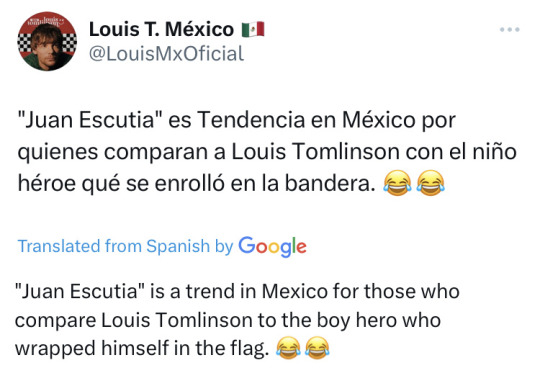


Louis draped in the Mexican flag at Tecate Pal Norte, 30 March 2024

x
#Juan escutia#🇲🇽#Louis Tomlinson#boy hero#Mexican flag#Tecate Pal Norte#30 March 2024#Mexican history#mine
37 notes
·
View notes
Text









badass women of history ↝ frida kahlo, mexican artist and activist
feet, what do i need you for when i have wings to fly?
#frida kahlo#historyedit#historicaledit#history edit#historical edit#history#women in history#mexican history#art history#badass women of history#bwoh#historyedit*#historicaledit*#moodboard#moodboard*#mine
24 notes
·
View notes
Text
History memes #49
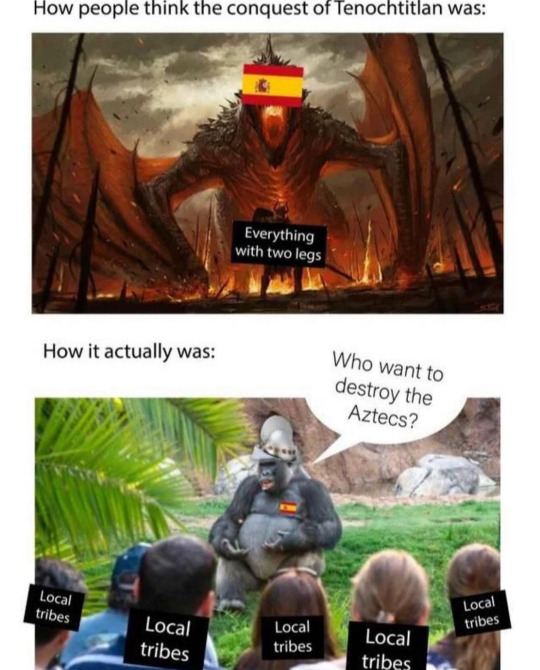
So, fun fact, most of the army that conquered the Aztecs were actually made up of other peoples in Mexico who decided they hated the Aztecs more than the newly arrived Spanish
#funny humor#history memes#funny memes#history#funny#humor#meme humor#dark humor#aztec#aztec empire#spanish empire#spanish#spain#mexico#mexican history#conquistador#Spanish conquest of Mexico#1500s#renaissance#renaissance history
42 notes
·
View notes
Photo

Happy birthday Frida Kahlo!
Frida was born in Mexico City on 6 July 1907. Frida is best known for her iconic self-portaits, and her art draws on both European and Mexican traditions to focus on themes including gender, revolutionary politics, and Mexican nationalism.
Frida’s works were exhibited during her lifetime in several countries, including at the USA’s MoMA. In 1939, the Louvre purchased one of the portraits, making her the first Mexican artist included the their collection.
Frida was married for much of her life to fellow artist Diego Rivera, and also had relationships with several women.
Learn more
[Image: Frida in traditional Mexican dress including a headscarf, pink shawl, and jewellery ]
351 notes
·
View notes
Text
Observe a 3D Reconstruction of Tenochtitlan
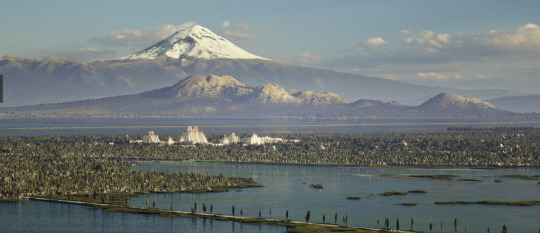
As history and archaeology gain more insight into the stories of the indigenous Americas, we get more tools to learn about them.
Here you can see a reconstruction of Tenochtitlan, at its height in the 15th century, with some of the most advanced science and art around the world. The population ranged somewhere between 200,000 to 400,000 and was the seat of power of the Triple Alliance (sometimes called the Aztec Empire).
See more reconstruction photos here!
127 notes
·
View notes
Text
#selena quintanilla perez#selena quintanillla#Selena#uploads#videos#such a fcking legend#90s women#mexican history#historia#historia mexicana#decade: 1990s#1990s#90s
52 notes
·
View notes
Text

⚠️Newly digitized collection alert!⚠️
This collection of Spanish and Mexican materials from 1781-1882 includes two hand drawn maps and a small collection of letters, written in Spanish.
Explore the collection on our online catalog: https://delivery.library.ca.gov:8443/delivery/DeliveryManagerServlet?dps_pid=IE326485
#spanish#spanish language#mexico#mexican history#history#1700s#1800s#maps#digitization#libraries#librarians
16 notes
·
View notes
Text
i’ve got santa anna/antonio enthusiasts watching me so therefore i drop all my memes (one made by yours truly) 🫡
i’m sorry it’s not a lot guys i’ll get more soon criessss



#alamo#the alamo#texas#texas history#historical#history#santa anna#antonio lopez de santa anna#mexican history#mexican revolution#mexican american war#mexico#1836#1800s mexico#history memes#memes
13 notes
·
View notes